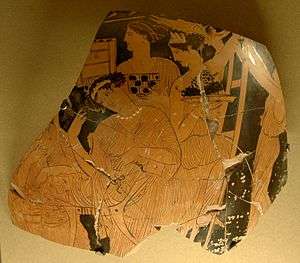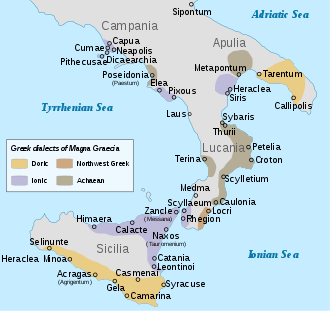Adonia
The Adonia (Greek: Ἀδώνια) was a festival celebrated annually by women in ancient Greece to mourn the death of Adonis, the consort of Aphrodite. It is best attested in classical Athens, though other sources provide evidence for the ritual mourning of Adonis elsewhere in the Greek world, including Hellenistic Alexandria and Argos in the second century AD.

Athenian festival
In Athens, the Adonia took place annually,[1] and was organised and celebrated by women. It was one of a number of Athenian festivals which were celebrated solely by women and addressed sexual or reproductive subjects – others included the Thesmophoria, Haloa, and Skira.[2] Unlike these other festivals, however, the Adonia was not state-organised, or part of the official state calendar of religious celebration,[3] and prostitutes as well as respectable women celebrated the Adonia.[4]
Over the course of the festival, Athenian women took to the rooftops of their houses. They danced, sang, and ritually mourned the death of Adonis. They planted "Gardens of Adonis" – lettuce and fennel seeds, planted in potsherds – which sprouted before withering and dying. After the rooftop celebrations, the women descended to the streets with these Gardens of Adonis, and small images of the god; they then conducted a mock funeral procession, before ritually burying the images and the remains of the gardens at sea or in springs.[5] The rites observed during the festival are not otherwise paralleled in ancient Greek religion; like Adonis himself they probably originated in the Near East.[6]
Date
The date of the Adonia at Athens is uncertain, with ancient sources contradicting one another. Aristophanes, in his Lysistrata, has the festival take place in the early spring of 415 BC, when the Sicilian Expedition was proposed; Plutarch puts the festival on the eve of the expedition's setting sail, in midsummer that year.[1] Theophrastus' Enquiry into Plants (Περι φυτων ιστορια) and Plato's Phaedrus are both often taken as evidence for the Adonia having been celebrated in the summer.[7] In Egypt and Syria in the Roman period, the Adonia coincided with the rising of the star Sirius in late July. As the Sicilian Expedition sailed in June 415, this contradicts both Aristophanes' and Plutarch's dating of the Adonia; the Athenian Adonia must have been celebrated at a different time.[8]
Modern scholars disagree on which of these sources is correct. Many agree with Plutarch, and put the festival around midsummer, though Dillon argues that Aristophanes' placement of the festival near the beginning of spring is "without question" correct.[1] Some scholars, such as James Fredal, suggest that there was in fact no fixed date for the Adonia to be celebrated.[9]
Gardens of Adonis
.jpg)
The main feature of the festival at Athens were the "Gardens of Adonis",[10] broken pieces of terracotta which had lettuce and fennel seeds sown in them.[4] These seeds sprouted, but soon withered and died.[4] Though most scholars say that these gardens withered due to being exposed to the heat of the summer,[11] Dillon, who believes that the Adonia was held in the spring, says that the plants instead failed because they could not take root in the shallow soil held by the terracotta shards.[4] In support of this, he cites Diogenianus,[12] who says that in the Gardens of Adonis, seedlings "wither quickly because they have not taken root".[13] In ancient Greece, the phrase "Gardens of Adonis" was used proverbially to refer to something "trivial and wasteful".[10]
Outside Athens
Outside of Athens, a celebration of Adonis is attested in Hellenistic Alexandria, in Theocritus' 15th Idyll. The festival described by Theocritus, unlike the one celebrated in Athens, was a cult with state patronage.[14] It included an annual competition between women singing dirges for Adonis.[15] Rites lamenting the death of Adonis are also attested in Argos in the second century AD: the Greek geographer Pausanias describes the women of Argos mourning Adonis' death at a shrine inside the temple of Zeus Soter.[16] Also in the second century, On the Syrian Goddess, attributed to Lucian, describes an Adonia celebrated in Byblos. There is no mention of Gardens of Adonis at this festival, but ritual prostitution and mystery rites are involved in the celebrations. Laurialan Reitzammer argues that the festival described by Lucian is one that was brought back to Syria from Greece, rather than being of native Syrian origin.[17]
References
- Dillon 2003, p. 1.
- Goff 2004, p. 121.
- Dillon 2002, p. 109.
- Dillon 2002, p. 165.
- Fredal 2002, p. 602.
- Burnett 2012, p. 187.
- Dillon 2003, pp. 8–9.
- Dillon 2003, p. 7.
- Fredal 2002, p. 603.
- Goff 2004, p. 58.
- Dillon 2002, p. 166.
- Dillon 2003, p. 4.
- Diogenianus, Παροιμιαι Δημωδεις, 1.14
- Dillon 2003, p. 2.
- Dillon 2002, p. 163.
- Dillon 2003, pp. 2–3.
- Reitzammer 2016, p. 28.
Works cited
- Burnett, Anne (2012). "Brothels, Boys, and the Athenian Adonia". Arethusa. 45 (2).CS1 maint: ref=harv (link)
- Dillon, Matthew (2002). Girls and Women in Classical Greek Religion. London: Routledge. ISBN 0415202728.CS1 maint: ref=harv (link)
- Dillon, Matthew (2003). "'Woe for Adonis' – but in Spring, not Summer". Hermes. 131 (1).CS1 maint: ref=harv (link)
- Fredal, James (2002). "Herm Choppers, the Adonia, and Rhetorical Action in Ancient Greece". College English. 64 (5).CS1 maint: ref=harv (link)
- Goff, Barbara (2004). Citizen Bacchae: Women's Ritual Practice in Ancient Greece. Berkeley: University of California Press. ISBN 0520239989.CS1 maint: ref=harv (link)
- Reitzammer, Laurialan (2016). The Athenian Adonia in Context. Madison: University of Wisconsin Press. ISBN 9780299308209.CS1 maint: ref=harv (link)
